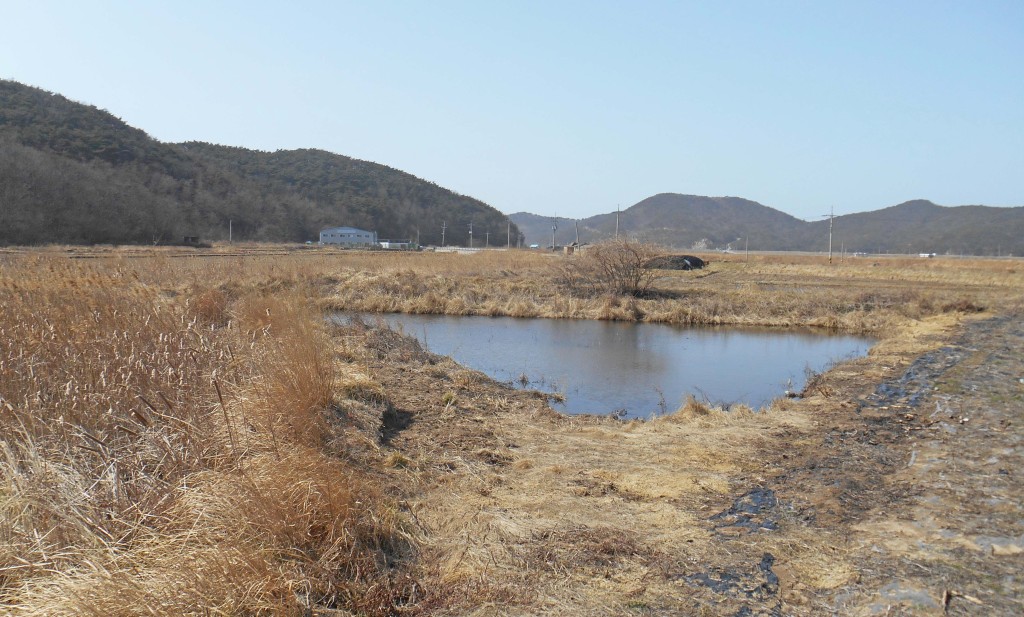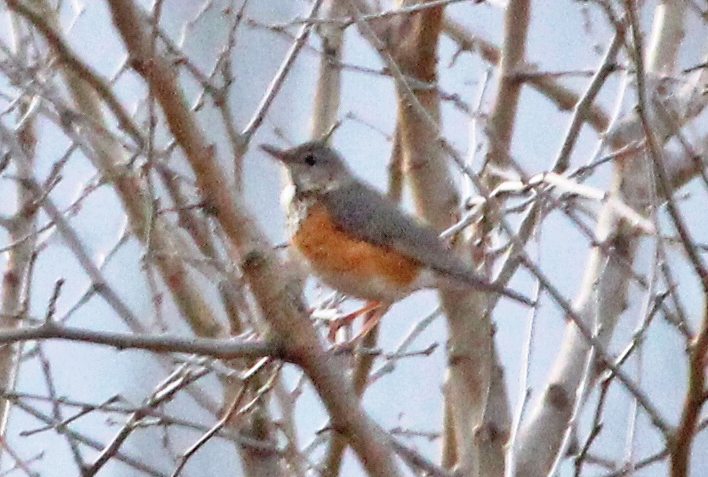Matt Poll & Tim Edelsten. An enjoyable trip to this familiar island some 45km offshore from Incheon. There was a surprising amount of early spring bird movement in evidence. Despite the ongoing construction of a new road and bridge linking this island with neighbouring Soya-Do, we were pleasantly surprised to find some picturesque and hithertoo unexplored corners of unspoilt and undeveloped habitat still remaining, at e.g. Neung-Dong in the northwest (reeds) and Beotgae in the south (reservoir, ricefields and pools). Temperatures were fairly mild through the period, with e.g. a high of 16 deg. celsius on the 6th- broken by a strong storm and heavy rain on the 5th.
Neung-Dong. © Matt Poll
Beotgae. © Tim Edelsten
1. Tundra Bean Goose Anser serrirostris. A raft of 105 on the sea off Beotgae on the 3rd had departed by the 6th.
2. Whooper Swan Cygnus cygnus. A flock of 42 appeared over Beotgae on the 3rd and headed northeast – a first for the island.
3. Eurasian Wigeon Anas penelope. A pair photographed in the bay on the 4th and 6th.
4. Mallard Anas platyrhynchos. Three off Beotgae and 493 in the bay off Seopo-ri on the 6th represents a surprisingly high concentration for an offshore island. All the drakes were in prime condition and looked glorious in the bright sunshine. They were mostly in pairs: some were copulating.
5. Eastern Spot-billed Duck Anas zonorhyncha. Fair numbers off the south coast, with 450+ off Beotgae on the 3rd (TE).
6. Northern Pintail Anas acuta. Six dropped into the School bay on March 4th, and had moved on by the next morning. Most records from Yellow Sea offshore islands involve only singles.
7. Eurasian Teal Anas crecca. A handsome flock of 161, in immaculate breeding plumage, were on the reservoir on the 3rd and 6th (with two also off Seopo-ri on the 6th). The males were duelling head-to-head in an anticlockwise rotation, and the whole flock was constantly whistling. This represents a very high concentration for an offshore island.
8. Common Pochard Aythya ferina. Twelve on the reservoir at Beotgae on the 3rd later flew and landed on the sea. There are very few previous offshore records.
9. Tufted Duck Aythya fuligula. A male in a ricefield pool at Beotgae on the 6th (TE) is a first record for the island and a rare offshore record.
Tufted Duck Aythya fuligula © Tim Edelsten
10. Red-breasted Merganser Mergus serrator. Seen daily, with e.g. eleven off Igae on the 2nd.
11. Common Pheasant Phasianus colchicus. Well-distributed throughout the island.
12. Great Crested Grebe Podiceps cristatus. One or two seen daily on the sea. All in breeding head-dress.
13. Grey Heron Ardea cinerea. Several at Beotgae were already flushed with pink legs and bills. An overhead flock of 13 moved through on the 5th.
14. Great Egret Ardea alba. Single numbers of alba, some flush with pale flesh-coloured tibia.
15. Temminck’s Cormorant Phalacrocorax capillatus. Two or three along the coast, in full breeding plumage.
16. Eurasian Sparrowhawk Accipiter nisus. one or two seen daily over the mountain ridges, with a line of four apparently moving NE on the 4th.
17. Northern Goshawk Accipiter gentilis. One or two seen every day – both juveniles and adults. They tend to watch from high perches along forest edge or overlooking open areas.
18. Eastern Buzzard Buteo japonicus. Seen daily. Two engaged in circling and clashing over Beotgae on the 6th.
19. Eurasian Oystercatcher Haematopus ostralegus. Thirty-six in the school bay on the 3rd was the high-count.
20. Black-tailed Gull Larus crassirostris.
21. Mongolian Gull Larus mongolicus. Up to five seen daily. They looked pretty sleek although still retaining a dirty collar around the hindneck.
22. Heuglin’s Gull Larus (heuglini) taimyrensis. Two or three idling in the bay.
23. Feral Pigeon Columba livia var. “domestica”. One in the port briefly on the morning of the 7th.
24. Oriental Turtle Dove Streptopelia orientalis. Surprisingly few, although six at the school area on the 4th.
Oriental Turtle Dove Streptopelia orientalis © Tim Edelsten
25. Great Spotted Woodpecker Dendrocopos major. Seen daily, in all parts of the island.
26. Common Kestrel Falco tinnunculus. A female hunting at Beotgae on the 6th (TE).
27. Peregrine Falcon Falco peregrinus. A pair over the reservoir at Beotgae on the 3rd intimidated the wildfowl.
28. Bull-headed Shrike Lanius bucephalus. One male at Seopo-ri on the 5th was heard to impersonate a White Wagtail and other passerines. Is this a hunting lure I wonder?
29. Eurasian Jay Garrulus glandarius. Very vocal and showy, with small groups constantly squabling amongst eachother. One was heard to mimic a Grey-headed Woodpecker: another sounded very like a Eurasian Kestrel.
30. Eurasian Magpie Pica pica. Abundant on the island, including a count of 60 individuals in one tree at Seopo-ri on the 5th.
31. Rook Corvus frugilegus. A flock of 38 at Beotgae on the 3rd and 6th.
32. Large-billed Crow Corvus macrorhynchos. A small number seen.
33. Coal Tit Periparus ater. Surprisingly plentiful everywhere, with e.g. 60+ in one small 20m patch of forest on the 3rd.
34. Varied Tit Sittiparus varius. Common throughout the island.
35. Eastern Great Tit Parus minor. Abundant, including e.g. roving flocks of 50 at Seopo-ri on the 5th and 60 in the northwest on the 6th (MP).
36. Eurasian Skylark Alauda arvensis.Two at Beotgae on the 3rd.
37. Light-vented Bulbul Pycnonotus sinensis. Found in two villages, with e.g. at least 12 at the school on the 4th and two at Beuk-ri on the 6th- with pairs having the feel of staking out territory in the stands of bamboo.
Light-vented Bulbul Pycnonotus sinensis © Tim Edelsten
38. Brown-eared Bulbul Hypsipetes amaurotis.
39. Long-tailed Tit Aegithalos caudatus. Resident magnus are common. Three caudatus at Beotgae on the 3rd (TE) and two at Seopo-ri on the 6th (MP).
Long-tailed Tit Aegithalos c. caudatus © Matt Poll
40. Goldcrest Regulus regulus. Fairly common in pines throughout the island.
41. Eurasian Wren Troglodytes troglodytes. Four in the northwest on the 6th (MP).
42. Eurasian Nuthatch Sitta europaea. One heard clearly at Igae on the 4th (MP) is a scarce offshore record.
43. White-cheeked Starling Spodiopsar cineraceus. Seen almost daily, with a high count of 17 at the school village on the 4th.
44. Grey-backed Thrush Turdus hortulorum. One in Seopo-ri on the 6th (MP) is judged likely to have overwintered, becoming only the third national record of overwintering.
Grey-backed Thrush Turdus hortulorum © Matt Poll
Grey-backed Thrush Turdus hortulorum © Matt Poll
45. Pale Thrush Turdus pallidus. One or two seen daily.
46. Naumann’s Thrush Turdus naumanni. Up to ten seen daily around the gardens and villages.
47. Dusky Thrush Turdus eunomus. One at Beotgae on the 3rd and one at Seopo-ri on the 6th.
48. Red-flanked Bluetail Tarsiger cyanurus. A female near the school on the 4th (TE) and another in the northwest on the 6th (MP).
49. Daurian Redstart Phoenicurus auroreus. Two or three seen or heard most days.
50. Eurasian Tree Sparrow Passer montanus. Thirty-five at Beotgae on the 6th, sounded distinctly different to those on the mainland.
51. Siberian Accentor Prunella montanella. Seen in various locations, with e.g. at least eight along the rope walk on the 3rd.
52. Grey Wagtail Motacilla cinerea. A near breeding-plumaged male at Igae on the 6th (MP).
53. White Wagtail Motacilla alba. Several leucopsis, e.g. eight at Igae on the 6th (MP).
54. Olive-backed Pipit Anthus hodgsoni. Six near the school on the 3rd and lesser numbers elsewhere.
55. Brambling Coelebs montifringilla. Only two on the 2nd and one on the 3rd.
56. Hawfinch Coccothraustes coccothraustes. Two near the port on the 3rd. Eight in Seopo-ri and two in the northwest on the 6th.
57. Long-tailed Rosefinch Carpodacus sibiricus. Two at Beotgae and two at Seopo-ri on the 6th.
58. Grey-capped Greenfinch Chloris sinica. A small number of individuals dotted over the island, including six in pines near the school on the 4th.
59. Eurasian Siskin Spinus spinus. Small numbers daily in the pines, including a dozen at Seopo-ri on the 6th.
60. Meadow Bunting Emberiza cioides. Seen in various parts of the island, with the highest density of up to 20 in the unspoilt overgrown ditches and ricefields of Beotgae on the 3rd.
61. Chestnut-eared Bunting Emberiza fucata. A pair at Beotgae on the 3rd (TE).
62. Little Bunting Emberiza pusilla. Only one, at Beotgae on the 3rd.
63. Rustic Bunting Emberiza rustica. Quite common throughout, with flocks of e.g. 50+ at Beotgae on the 6th (TE).
64. Yellow-throated Bunting Emberiza elegans. Abundant everywhere and singing on every hillside- an impressive density.
65. Pallas’s Reed Bunting Emberiza pallasi. One at Beotgae on the 3rd.
Igae mudflat and wetland © Matt Poll









